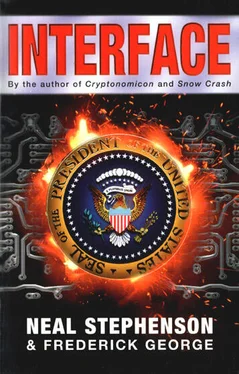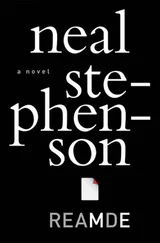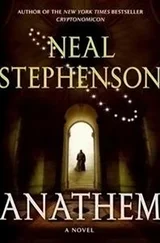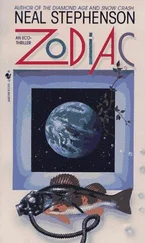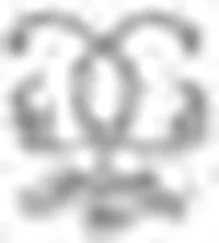Neal Stephenson - Interface
Здесь есть возможность читать онлайн «Neal Stephenson - Interface» весь текст электронной книги совершенно бесплатно (целиком полную версию без сокращений). В некоторых случаях можно слушать аудио, скачать через торрент в формате fb2 и присутствует краткое содержание. Жанр: Фантастика и фэнтези, на английском языке. Описание произведения, (предисловие) а так же отзывы посетителей доступны на портале библиотеки ЛибКат.
- Название:Interface
- Автор:
- Жанр:
- Год:неизвестен
- ISBN:нет данных
- Рейтинг книги:4 / 5. Голосов: 1
-
Избранное:Добавить в избранное
- Отзывы:
-
Ваша оценка:
- 80
- 1
- 2
- 3
- 4
- 5
Interface: краткое содержание, описание и аннотация
Предлагаем к чтению аннотацию, описание, краткое содержание или предисловие (зависит от того, что написал сам автор книги «Interface»). Если вы не нашли необходимую информацию о книге — напишите в комментариях, мы постараемся отыскать её.
Interface — читать онлайн бесплатно полную книгу (весь текст) целиком
Ниже представлен текст книги, разбитый по страницам. Система сохранения места последней прочитанной страницы, позволяет с удобством читать онлайн бесплатно книгу «Interface», без необходимости каждый раз заново искать на чём Вы остановились. Поставьте закладку, и сможете в любой момент перейти на страницу, на которой закончили чтение.
Интервал:
Закладка:
Inside the wrapping was a featureless hard plastic box, white and unmarked, that had to be opened using some trick that Dr. Radhakrishnan could not figure out right away. When the box had been penetrated, the entire contents turned out to have been sealed in plastic wrap, like a glass in a motel room. Dr. Radhakrishnan knew that in the context of American culture, to seal something up in plastic was to honor it.
The contents turned out to be a short stack of unmarked 3.5-inch floppy disks. He remembered that he and Mr. Salvador had had a discussion about the Calyx operating system, so, on a hunch, he popped one of the disks into the Pacific Netware workstation on his desk.
The systems were compatible. There were a few files stored on the disk, all in a standard format used for color images. They all sounded like medical scans of one type or another. Dr. Radhakrishnan opened some of them up and checked them out; these files were all pictures of the same man's brain. The man had suffered a stroke that had, to judge from the position of the two affected areas, probably interfered with his speech and caused some paralysis on the left side. Interestingly enough, the affected parts of the brain were isodense, which is to say that they had the same density as the healthy parts of the brain surrounding them. This indicated that these pictures had been taken within a few days of the stroke.
It did not take much imagination on Dr. Radhakrishnan's part to realize that he was looking at the brain of Mr. Salvador's friend. Mr. Salvador was implicitly asking him a question: is this the type of damage that you can fix?
And the answer was yes. In theory. But the facility that would be required to do the work did not exist and wouldn't exist for years, even with preposterously optimistic assumptions about grants and funding. Oh, you could build one anytime you wanted, if you had the money. But who had that kind of money?
Dr. Radhakrishnan eventually outsmarted the latching system on the tube. Rolled up inside was a thick stack of poster-sized sheets of paper.
In his cluttered lab it took some doing just to find a table large enough to unroll them. Finally he chased Toyoda out of the coffee room, where he had been watching MTV, and cleared off the counter, wiped up a few spills with a napkin, and unrolled the pages across the wood-grained Formica. Unrolled, the stack of sheets was nearly half an inch thick. They were all the same size, and all covered with precise, colorful drawings.
Flipping quickly through the stack he saw floor plans, elevations, detailed renderings of individual rooms. The top sheet was an elevation. It portrayed a modern, high-tech structure perched on a piney bluff overlooking the sea. There was a modest parking lot, a satellite dish on the roof, lots of windows, an outdoor cafeteria, even a bicycle path. Looked like a nice place to work.
The second sheet was an elevation of an entirely different building. This one was in an urban setting. It had an austere sand-stone color with a few darkly tinted windows set up above street level. It was also high-tech, but at the same time it was strikingly Indian: he could see the classic motifs of Hindu architecture, updated and streamlined. The materials were unusual: reinforced concrete where it counted, of course, but sandstone and marble on the outside, even some traditional inlay work.
The third sheet showed the same building from a higher angle, revealing a central, glassed-in atrium lined with offices and a bloom with lush flowering tropical plants. Behind it, a neighborhood of low, blocky concrete structures stretched toward a somewhat more built-up district a few blocks away, centered on a huge circular roadway lined with shops and offices.
Dr. Radhakrishnan was shocked to recognize the ring road: it was Connaught Circus, the solar plexus of his home city of New Delhi. Once he figured that out, everything snapped into focus, he understood which direction he was looking in, recognized the shapes of the Volga Hotel and the glassfront of the big British Airways office on the Circus, the entrances to the underground bazaar.
He knew exactly where this building was. It had been drawn in on the site of the Ashok Cinema, a memorable, if decrepit structure, where Papa had taken him to movies as a child. Right in between Connaught Circus and the India Gate, close to the seat of government, embassies, everything.
If this building - whatever it was - was really under construction, or even being contemplated, it was news to him. He should have heard about it by now, because fancy new high-tech structures did not spring up every day there. Dr. Radhakrishnan did not know what this building was, but he could recognize high-tech architecture when he saw it. It seemed that someone had ambitious plans to create a sort of silicon ashram.
Maybe this was some sort of an investment opportunity. Or maybe they were trying to attract researchers to this new complex, But it had to be a far-off fantasy on someone's part because if ground had been broken in Delhi - if this plan had even been whispered - Dr. Radhakrishnan would have heard about it. He was not the most well connected Delhian by a long shot, but he knew people and he stayed in touch.
He continued paging through the stack, trying to glean some clues. The drawings alternated between the two buildings: the one on the bluff above the sea and the one in Delhi. Space was set aside for offices, R&D, laboratories, operating rooms, and even a few private bedrooms, complete with all of the equipment you would expect to see in a state-of-the-art intensive-care ward. Evidently these buildings were for biomedical research of the most advanced sort.
The building in Delhi included one operating theater that was especially large and complicated. Dr. Radhakrishnan found a detailed plan of the room and went over it carefully, growing more and more certain as he did so that he had seen this before: it was an exact reproduction of the specialized operating room that he had described to Mr. Salvador. The one that Mr. Salvador had taken with him on those disks. The plans for Radhakrishnan's ultimate operating theater had simply been dropped whole into the blueprints for a new building. But it wasn't a hack job. The systems had all been integrated into their surroundings. The plumbing lines, the electrical wiring, the gas lines, all went somewhere. Subtle modifications had been made without changing the essential features. In fact, the room had been improved in several ways. Engineers had been at work on this. Very good engineers.
Dr. Radhakrishnan was beginning to experience a prickly, hot feeling centered on the back of his neck, as though he were the victim of a joke of psychological experiment. He shuffled quickly through the stack, trying to get clues, looking for a point of reference. But he couldn't find anything that explained whether this was reality or fantasy, who had these plans drawn up, or why.
Until he got to the last sheet, which showed an elevation of the front entrance of the building in Delhi. The doorway was surrounded by a massive masonry frame. The material had a rich red hue, the color of Indian sandstone. The name of the building was carved into flat square stone next to the door, a Rosetta stone in English and Hindi:
DR. RADHAKRISHNAN V.R.J.V.V. GANGADHAR
INSTITUTE OF BIOMEDICAL RESEARCH - DELHI BRANCH
He read it over several times, as though this were the first time he had ever seen his own name written down.
He sifted back through the stack, looking for elevations of the building above the ocean. Finally he dug up an elevation showing it from ground level, with a concrete marker set into the ground by the entrance to the parking lot:
ROBERT J. COOVER BUILDING
DR. RADHAKRISHNAN V.R.J.V.V. GANGADHAR
INSTITUTE OF BIOMEDICAL RESEARCH - CALIFORNIA BRANCH
Читать дальшеИнтервал:
Закладка:
Похожие книги на «Interface»
Представляем Вашему вниманию похожие книги на «Interface» списком для выбора. Мы отобрали схожую по названию и смыслу литературу в надежде предоставить читателям больше вариантов отыскать новые, интересные, ещё непрочитанные произведения.
Обсуждение, отзывы о книге «Interface» и просто собственные мнения читателей. Оставьте ваши комментарии, напишите, что Вы думаете о произведении, его смысле или главных героях. Укажите что конкретно понравилось, а что нет, и почему Вы так считаете.
